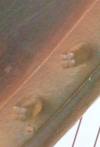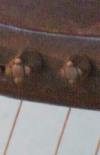

|

The Downhill harp bears two inscriptions in slightly naive Roman capitals, deeply and neatly incised into the wood.
The first and most prominent is on the forepillar, facing outward, so it is clearly visible to anyone seeing the harp being played. This inscription reads "C O DEVLIN". Presumably this was the harp's first owner.
The harp was made in 1702, and it is said to have been purchased for 18-year-old Denis O’Hampsey (1695-1807) in 1713 (if we accept his claimed year of birth) by his first patron, Counsellor Canning, in Garvagh, Co. Derry, along with two other gentlemen, Gage and Bacon. So it seems sensible to assume that C O’Devlin may have been the owner of the harp between 1702 and 1713.
The second inscription is on the right hand side of the soundbox, visible to the player, or when the harp is resting on its back. It reads:
[...]E TME OF NOAH IXAS GREEN
[...] HIS FLOOD I HAVE NOT BEEN SEEN
UNTIL 17 HVNDRED AND 02 I VAS FOVND BY CR KELY VNDERGROVND
HE RAISED ME VP TO THAT DEGREE QUEEN OF MVSICK YV MAY CALL ME

Interesting points about this inscription are the reversed N, the same as in C O’Devlin, and the numerous clever ligatures joining letters together. The date 1702 and the name CR Kely give the harp its original provenance. The reference to ‘underground’ has led many people to suppose that the harp was made from bog wood, but this seems unlikely to me - the colour is far too pale (though we still await properly published scientific analysis and identification of the wood). I think it is more likely some kind of literary allegory, connected to the ‘time of Noah’.

 The ends of the tuning pins bear patterns that, while not inscriptions, are also not decorations, since they seem functional. Pins below na comhluighe have crosses incised on their ends, while pins above na comhluighe have diamonds. It is possible that these symbolise the feminine treble voice and the masculine bass voice of the harp. The two pins of Na Comhluighe have their ends so worn away that no pattern is discernable.
The ends of the tuning pins bear patterns that, while not inscriptions, are also not decorations, since they seem functional. Pins below na comhluighe have crosses incised on their ends, while pins above na comhluighe have diamonds. It is possible that these symbolise the feminine treble voice and the masculine bass voice of the harp. The two pins of Na Comhluighe have their ends so worn away that no pattern is discernable.